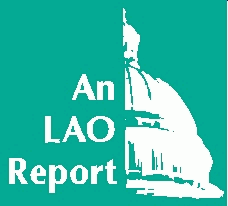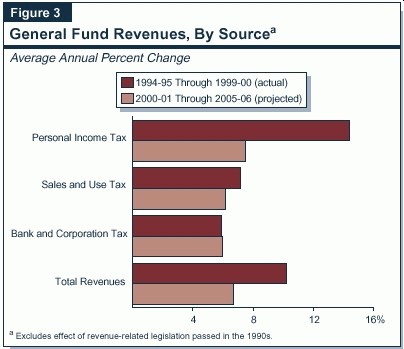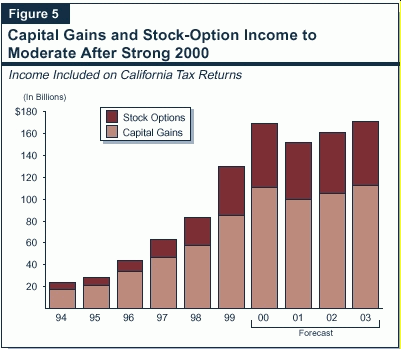
 |
California's Fiscal OutlookLAO Projections2000-01 Through 2005-06 |
California's revenue outlook has continued to improve substantially since the 2000-01 Budget Act was signed in June. The forecast underlying the budget assumed that revenue growth would slow sharply in 2000-01, reflecting more moderate economic performance during 2000 accompanied by declines in capital gains and stock options. Over the last several months, however, it has become apparent that revenue trends are much stronger than anticipated last spring.
Reflecting these recent positive fiscal trends, our updated forecast calls for another year of strong revenue growth in 2000-01, followed by more moderate, but still healthy gains in subsequent years. The forecast is discussed in more detail below and summarized in Figure�1.
| Figure 1 | ||||||||
| The LAO's General Fund Revenue Forecast | ||||||||
| (Dollars in Millions) | ||||||||
| Revenue Source | Preliminary | Forecast | ||||||
| 1999-00 | 2000-01 | 2001-02 | 2002-03 | 2003-04 | 2004-05 | 2005-06 | ||
| Personal income tax | $39,471 | $44,190 | $45,810 | $49,240 | $53,000 | $56,860 | $61,060 | |
| Sales and use tax | 21,109 | 22,068 | 22,910 | 24,960 | 26,590 | 28,380 | 30,300 | |
| Bank and corporation tax | 6,663 | 7,178 | 7,550 | 7,980 | 8,420 | 8,910 | 9,430 | |
| Other revenues and transfers | 4,470 | 4,490 | 4,769 | 4,978 | 5,147 | 5,400 | 5,675 | |
| Total revenues and transfers | $71,713 | $77,926 | $81,039 | $87,158 | $93,157 | $99,550 | $106,465 | |
| Percent change | 22.3% | 8.7% | 4.0% | 7.6% | 6.9% | 6.9% | 6.9% | |
We estimate that revenues in 1999-00 totaled $71.7�billion, or $551�million more than assumed in the 2000-01 Budget Act. Cash receipts in May and June 2000 were up by a combined total of $789�million relative to the May Revision forecast. The final budget recognized $238�million of that total, but did not incorporate the remaining $551�million. Total receipts in 1999-00 increased by over 22�percent from 1998-99, the largest gain in recent history.
We forecast that General Fund revenues will total $77.9�billion in 2000-01, an 8.7�percent increase from the prior year. Our forecast includes the effects of legislation enacted earlier this year which will result in the diversion for transportation-related purposes of $500�million in General Fund revenues. It also includes a $540�million revenue reduction associated with the "triggering off" of a one-quarter cent share of the state sales tax rate beginning on January 1, 2001 (see shaded box). Even with this latter reduction--which the 2000-01 Budget Act did not anticipate--our revised 2000-01 revenue estimate is still up by about $4.1�billion from the budget forecast. This higher estimate reflects California's continuing economic boom in 2000, as well as the much stronger-than-expected cash receipts from the sales and personal income taxes.
Our forecast assumes that revenues will total $81�billion in 2001-02, a 4�percent increase from the current year. The forecast includes the effect of the increased diversion of gasoline-related sales taxes from the General Fund to transportation funds, the remaining half-year of the triggered quarter-cent sales tax reduction, and the ongoing effects of other tax-related legislation passed last year. Absent the effects of these and other special factors, our underlying revenue growth rate for 2001-02 is about 5�percent.
This underlying rate of revenue growth represents a significant slowdown from the prior and current years. The slowdown is primarily due to our assumption that, after increasing dramatically in 1999 and 2000, personal income taxes attributable to capital gains and stock options will fall modestly next year. Over the longer term, we project that General Fund revenues will increase at an underlying annual rate of about 6.8�percent, reaching $106�billion by 2005-06.
General Fund revenue performance during the forecast period will be significantly affected by tax reductions and redirections approved in conjunction with the 2000-01 Budget Act, as well as the recent certification by the Director of the Department of Finance of a one-quarter cent sales tax reduction for calendar year 2001 (see earlier shaded box). Figure�2 (see page 16) shows the estimated fiscal effects of these and other actions.
Sales Tax Rate to "Trigger Off"On January 1, 2001, the General Fund sales tax rate will be reduced by a quarter cent--from 5�percent to 4.75�percent. This will correspondingly reduce the statewide average state and local sales tax rate from about 7.92�percent to roughly 7.67�percent. Current law requires this reduction to occur if the state's projected budgetary reserve (that is, the Special Fund for Economic Uncertainties, or SFEU) is certified to exceed 4�percent of revenues for the second year in a row. BackgroundIn 1991, with the state mired in a deep recession and facing severe budgetary shortfalls, the Legislature adopted a one-quarter percent increase in the General Fund's existing sales tax rate of 4.75�percent. The law also provided that it would "trigger off" in any year if the Director of the Department of Finance certifies on or before November 1 that the SFEU (1) exceeded 4�percent of General Fund revenues in the prior year and (2) also is projected to do so in the current year. The latter projection is to be made assuming that the quarter-cent reduction is in place the remaining six months of the fiscal year involved. The law also provided that once triggered off, the quarter-cent rate would again "trigger on" if the 4�percent threshold was not met in any subsequent year. Thus, a permanent "toggle" was established whereby the quarter-cent rate could flip back-and-forth from being "on" or "off" depending on the size of the SFEU. Any required sales tax increase or decrease becomes effective on January 1 following the certification. Fiscal EffectThis is the first time that the quarter-cent rate will trigger off, reflecting the Director's certification that the SFEU for 1999-00, and that projected for 2000-01, exceeds 4�percent of revenues. Our own projections confirm this. We estimate that the full-year effect of the 2001 rate reduction will be to reduce General Fund sales tax revenues by approximately $1.2�billion, with $540�million occurring in 2000-01 and $630�million in 2001-02. In subsequent years, our forecast treats the issue of whether the quarter-cent rate will be on or off as a policy decision. Under current law, we forecast that the SFEU will exceed 4�percent of revenues throughout the forecast period. However, the Legislature's future spending and taxation decisions and the actual course of California's economy will affect this assessment in the future. |
| Figure 2 | ||||||
| Fiscal Effects of Recent Revenue-Related Measures | ||||||
| (In Millions) | ||||||
| 2000-01 | 2001-02 | 2002-03 | 2003-04 | 2004-05 | 2005-06 | |
| Tax Reductions | ||||||
| Vehicle license fee acceleration | $887 | $1,426a | $553 | -- | -- | -- |
| New General Fund tax provisions | ||||||
| Credentialed teacher tax credit | $218 | $188 | $202 | $217 | $233 | $245 |
| Child care credit | 195 | 189 | 193 | 197 | 201 | 210 |
| Senior homeowners' and renters' tax assistance | 154 | -- | -- | -- | -- | -- |
| Targeted tax cuts | 88 | 161 | 133 | 136 | 158 | 190 |
| Totals, new General Fund tax provisions | $655 | $538 | $528 | $550 | $592 | $645 |
| Other Revenue-Related Provisions | ||||||
| Transportation sales tax diversion | $500 | $1,060 | $1,140 | $1,150 | $1,160 | $1,170 |
| Quarter-cent sales tax trigger | 540 | 630 | -- | -- | -- | -- |
| Totals, other revenue-related provisions | $1,040 | $1,690 | $1,140 | $1,150 | $1,160 | $1,170 |
| a Of this amount, $1,165 million was appropriated and counted as expenditures in 2000-01. | ||||||
The VLF Reduction. The 2000-01 tax package consisted principally of an acceleration of the cumulative 67.5�percent reduction in the vehicle license fee (VLF) tax rate. Under prior law, this reduction would have been phased in over several years and been fully implemented by January 2003. Under revised law, however, the full reduction will take place in January 2001. Since the VLF is a local revenue source, the accelerated reduction will result in increased General Fund expenditures to backfill local revenue losses. Compared to prior law, the increased subventions will total $887�million in 2000-01 and $1.4�billion in 2001-02.
New Provisions Affecting General Fund Taxes. The main provisions in this category are: (1) a tax credit of up to 50�percent of tax liabilities for credentialed teachers in public and private schools, with the maximum credit amount being related to years of experience; (2) a tax credit for taxpayers incurring expenses associated with long-term care of eligible elderly or disabled individuals in their homes; (3) a refundable tax credit for child care expenses for those taxpayers earning $100,000 or less; (4) targeted tax reductions, including tax credits for research and development expenses; and (5) expanded deductions for net operating losses.
As part of the 2000-01 budget agreement, $500�million of sales taxes on gasoline will be diverted from the General Fund to transportation-related special funds in 2000-01. In the following five years (2001-02 through 2005-06), the full amount of sales taxes on gasoline (about $1.1�billion per year) will be transferred. Also, as discussed earlier, a one-quarter cent sales tax reduction will take effect for calendar year 2001. This will reduce sales tax revenues by $540�million in 2000-01 and $630�million in 2001-02.
Over the next five years, we expect overall revenue growth to slow from its dramatic pace in recent years. As shown in Figure�3, we project that revenues will increase at an average annual rate of 6.8�percent during the 2000-01 through 2005-06 period, compared to the average annual increase of 10�percent that occurred for the 1994-95 through 1999-00 period. This projected slowing is reflective of our forecast for more moderate economic growth during the forecast period. It also reflects our assumption that growth in personal income taxes related to stock options and capital gains will subside from their recent robust pace.

Personal income tax (PIT) receipts have continued to grow at extraordinary rates in the second half of 2000. Cumulative net collections for the first four months of this fiscal year are up by over 20�percent from the prior year, reflecting major gains in both withholding collections and quarterly estimated tax payments. As shown in Figure�4, withholding payments grew at a 19�percent year-over-year pace through the first three quarters of calendar year 2000--nearly double the pace that would normally be expected during a period of economic expansion. The growth in quarterly estimated payments has been even stronger, topping 35�percent so far this year. These increases reflect both (1) healthy underlying growth in employment, wages, and business earnings, and (2) extraordinary increases in stock options and capital gains, which are being realized at an unprecedented rate in 2000.

Personal Income Tax Payments To Slow in 2001. We forecast that payments attributable to 2000 tax liabilities will remain strong through April 2001, when final payments are due. However, we also expect that payments attributable to 2001 liabilities will subside early next calendar year. While the economy is expected to remain healthy, we project that the roughly 30�percent of PIT revenues related to stock options and capital gains will fall modestly next year.
Specifically, as shown in Figure�5 (see page 18), we estimate that income related to capital gains and stock options increased by about 50�percent in 1999 and 30�percent in 2000, but that it will fall by 10�percent in 2001 before rebounding in 2002 and 2003.

Why the Drop in Options and Capital Gains? Based on company reports, it appears that the recent stock market volatility--especially in the high-tech sector--caused many company officers, employees, and investors to "cash in" stocks during 2000. This would have been done in order to "lock in" gains that had built up over the past several years. While this has boosted tax liabilities in 2000, this surge of activity has at the same time reduced the amount of unrealized gains available to be realized in 2001 and beyond. This is particularly true for investors and employees in high-tech companies that have experienced large declines in their share values in 2000. We expect the decline in stock market-related gains to be mitigated somewhat by increases in real estate-related capital gains. However, absent a significant upturn in the stock market, we believe overall gains and stock option-related income will fall some next year from their lofty recent peaks.
The PIT Revenue Forecast. Based on the assumptions discussed above, we estimate that PIT receipts will total $44.2�billion in the current year, up 12�percent from 1999-00. Our current estimate is up $2.9�billion from the 2000-01 Budget Act estimate. In 2001-02, we forecast that PIT receipts will increase by 3.7�percent--to $45.8�billion. Over the longer term, we forecast the revenues from this source will grow at an average annual rate of 7.5�percent, reaching $61.1�billion by 2005-06.
After several years of moderate growth, taxable sales increased sharply in 1999 and 2000. We estimate that taxable sales will increase by 11.7�percent in the current year, the largest gain since 1984. While some of the increase is due to the recent surge in gasoline prices, the majority is related to across-the-board strength in consumer and business spending. Factors underlying these major spending increases include high levels of wealth (both stock market and real estate related), consumer and business confidence, and personal income growth.
Looking ahead, we forecast that sales will increase by 6.7�percent in 2001--in line with our projected gain in personal income during the year. This forecast generally assumes continued healthy growth in most sales categories in California. It also assumes that gasoline prices will decline modestly from their recent high levels, reflecting less severe worldwide supply-demand imbalances in the crude oil markets.
Over the longer term, we forecast taxable sales increasing by about 6.3�percent per year. This average increase is modestly less than the projected annual increase in California personal income (6.8�percent). While levels of wealth and confidence will remain positive factors in the outlook, we expect that taxable sales growth will be restrained somewhat by the continued trend in the economy toward consumption of services and E-commerce. Most services and certain E-commerce transactions do not generate California sales and use tax (SUT) revenues.
The SUT Revenue Forecast. Receipts from the SUT over the next several years will be affected by both underlying changes in taxable sales and a variety of policy-related factors. The main factors are the one-year quarter-cent sales tax reduction and the diversion of sales taxes on gasoline to transportation funds discussed above. Taking into account these factors, we estimate that General Fund SUT receipts will be $22.1�billion in 2000-01, which is $750�million more than anticipated in the 2000-01 Budget Act. Thereafter, we forecast that SUT revenues will increase to $22.9�billion in 2001-02, a 3.8�percent increase from the current year, and then grow steadily to $30.3�billion by 2005-06.
After increasing at a sluggish pace for several years, bank and corporation tax (BCT) receipts jumped 16�percent in 1999-00, reflecting increased profits in most industries. Tax payments attributable to 2000 earnings are continuing to grow at a healthy pace. Based on limited payment data for the first half of calendar year 2000, it appears that most industries are experiencing healthy profit growth, with the exception of financial services and utilities (whose profits continue to be adversely affected by industry restructurings). We estimate that California taxable profits will increase by about 12�percent in 2000, before settling down to annual growth rates of about 6�percent during the balance of the forecast period.
The BCT Revenue Forecast. We forecast that BCT receipts will increase from $6.7�billion in 1999-00 to $7.2�billion in the current year. The current-year estimate is about $378�million above the 2000-01 Budget Act forecast, reflecting our projected higher level of corporate profits during the current year. We forecast that tax receipts will then rise by 5.2�percent, to $7.6�billion in 2001-02. In subsequent years, we project that receipts will increase by between 5.5�percent and 6�percent annually, to $9.4�billion by 2005-06.
We estimate that revenues from all other sources--including insurance premiums taxes, estate taxes, tobacco and alcohol-related taxes, interest earnings, and tobacco settlement payments--will remain flat at about $4.5�billion in 2000-01. In subsequent years, revenues from these other sources are forecast to rise at an average annual rate of about 4.4�percent, reaching $5.7�billion by 2005-06. Our forecast assumes moderate growth in receipts from insurance and estate taxes, marginal gains from the alcoholic beverage taxes, and modest declines in tobacco taxes.